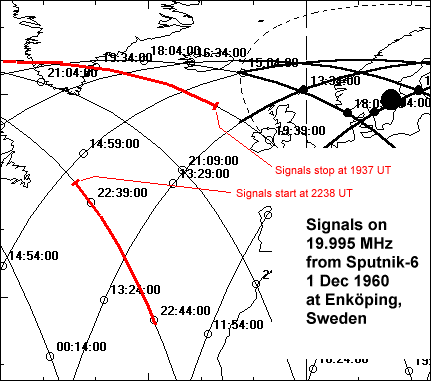 |
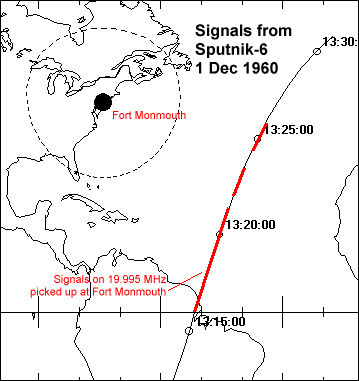 |
Officials in charge of
the Soviet manned spaceflight program (Ustinov, Keldysh, Korolev, Rudnev
and Moskalenko) sent a letter to the Central Committee on 10 November 1960
asking for permission to resume the flight testing of the Vostok spacecraft
(4).
The first Vostok-3A spacecraft, i.e. the version intended for manned flight
was indeed launched from Baikonur carrying the dogs Pchelka and Mushka
at 0726 UT on 1 December 1960. The spacecraft weighed 4563 kg and entered
an orbit at i = 64.97o and 172-238 km. This was the type of
orbit intended to be used for manned flights in order to permit natural
decay after ten days in case the retrorocket malfunctioned. Soviet media
announced that the spacecraft carried a transmitter "working in the telegraphic
transmitting regime of varying duration" on 19.995 MHz (5).
Soviet ground stations had twelve telemetry reception and orbit determination
sessions during the flight (14).
Now that the Cold War is over we know that U.S. Intelligence used the Radio Research Laboratories of the Japanese Ministry of Posts and Telecommunications to monitor Soviet manned flights by listening to 19.995 MHz. The Japanese did indeed pick up Sputnik 6 on the launch revolution. But first there was a strong jammer starting at 0727 UT, i.e. a minute after launch. As the jammer was switched off the Japanese picked up telemetry on 19.995 MHz as the spacecraft reached its first northern apex at 65 N and 125 E. In (15) the authors note with satisfaction that they picked up the signal before the Soviet announcement of the launch and that they noted the Doppler shift as a strong indication that they were listening to a spacecraft.
The monitoring station of Sweden's
Telecommunications Agency near Enköping did indeed pick up the
beacon signals on 19.995 MHz at 1023 UT, three hours after launch (6),
and then further until 1937 UT on 1 December when they stopped abruptly
(7).
They were heard again for a few minutes starting at 2238 UT (7). Wire services
also reported (1) that "undecipherable
signals were picked up by the U.S. Army Signal Corps on a frequency of
19.995 Megacycles". This must have been done at Fort Monmouth, New
Jersey where signals on 19.995 MHz at were picked up at 0816 a.m. (1316
UT) on December 1 according to (2).
 |
 |
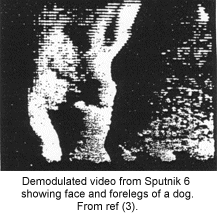 Television
images of the dogs received by intelligence agency
Television
images of the dogs received by intelligence agencySoviet media announced that because the "descent went along an unplanned trajectory the satellite spaceship ceased to exist when entering the dense layers of the atmosphere" (5). With hindsight we may say that this statement was entirely true, but gave the impression that the spacecraft had been destroyed because of natural causes - overheating and not a deliberate explosion. In (8), of course, the truth is stated: "The programme of the space flight was executed, but due to a failure in the control system of the TDU the descent was in an unforeseen area and the SA (landing apparatus) had to be blown up."
Interestingly, Korolev himself in (14) states that "after the separation [of the descent appartus] one more session of telemetry information was received from the instrument compartment of the ship before it re-entered the dense layers of the atmosphere".
If retro-fire occurred at 0822 UT and the craft continued for 1.5 revolutions, i.e. 2 hours 15 minutes, the re-entry occurred at about 1035 UT over the Pacific. By that time the descent appartus had separated from the instrument compartment. Interestingly the monitoring station of Sweden's Telecommunications Agency near Enköping reported that it had picked up last signals from the spacecraft on 19.995 MHz fading out at 1015-1017 UT (13) near the northern apex of the orbit. This could be part of that extra communications session that Korolev mentions! the fact that this communications session occurred at all was proof that the the de-orbit had failed.
In (15) the authors report that signals on 19.995 MHz ceased at 1020.11 UT when the spacecraft was at 62 N and 105 E.
The station at Enköping did not pick up telemetry during the closest approach to Sweden on the orbit on which the retro-rocket was fired. However, the station picked up the 19.995 MHz beacon twice during the two passes closest to Sweden before the retro-fire orbit, i.e. at 0540 UT, 0710 UT (3). Intriguingly, the station reported that at 1100 UT a strong radio jammer started transmitting on the beacon frequency and continued to do so until 1142 UT - as if to hide the fate of the spacecraft? (13). It is interesting that jamming also took place promptly after launch. (All the three receptions made at Enköping in the morning of 2 December 1960 are marked by light red ellipses in the map below).
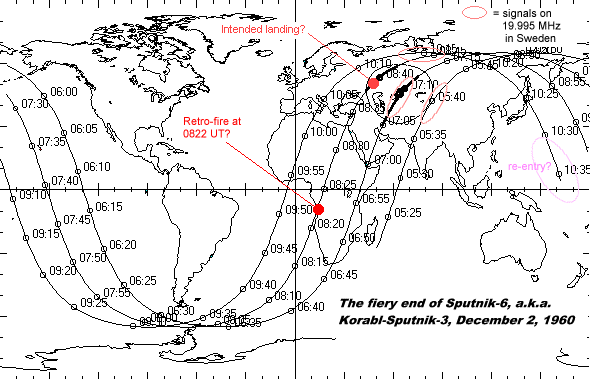
The way that the destruct system worked was that if the re-entry g-loads did not occur wihin a prescribed time the destruct system would be activated. Nominally, the descent apparatus would have been separated from the instrument compartment promptly after retrofire. If the descent apparus had been destroyed by on-board explosisves the instrument compartment was probably still intact.
Why did the retro-fire impulse not provide sufficient delta-v to bring the spacecraft down? Available sources are extremely vague on this matter. The infrared vertical sensor was not used on this flight to orient the ship for retro-fire. Instead the sun orientation system was used. In a separate article I have examined the orientation of the sun relative to the orbital path of all Vostok and Vostok test flights. The really intriguing thing about the flight of Korabl-Sputnik-3 is that the sun was almost perpendicular to the orbital path at retro-fire! So, the TDU-1 would not have changed the speed of the craft at all, merely deflected it a little bit! So, maybe the sketch of how the solar orientation system worked that is shown in the article "Vostok retro-fire attitude" does not show how this system worked, or the mission planners for this mission had made a horrible mistake and miscalculated the solar orientation for establishing the correct retro-fire attitude! Opinions are invited as to how this mystery can be solved....!
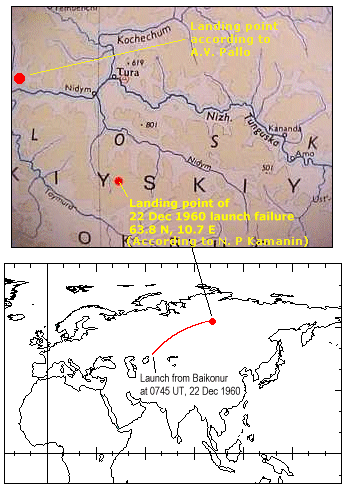 It
seems that Soviet officials quickly identified and corrected the failure
in the TDU retrorocket and proceeded to launch the next Vostok test flight
a mere three weeks after that launch of Sputnik-6.
It
seems that Soviet officials quickly identified and corrected the failure
in the TDU retrorocket and proceeded to launch the next Vostok test flight
a mere three weeks after that launch of Sputnik-6.
Kamanin's’ diaries starts on 17 December 1960, so regretfully just after the launch of Sputnik-6. Kamanin speaks about a "spherical object" to be launched in the second half of December 1960, obviously referring to the unsuccessful launch on 22 December. Kamanin writes that the ship will contain the dogs Zhemchuzhnaya and Zhulka and "all the small items like the 3d ship".
The "sphere " was indeed launched from Baikonur at 0745 UT on 22 December 1960 and did not reach orbit. The Blok-E stage of the launch vehicle shut down at T+432 sec. The craft reached an apogee of 214 km, re-entered the atmosphere and landed 3500 km downrange, 70 km south of Tura village in the independent district of Evenkiyskiy in the Krasnoyarsk region. Nevertheless it landed safely and the dogs were still alive. Bearings came from the object from Krug stations (powerful direction-finders of of the air force) around Tashkent. Also Moscow and Krasnodar picked transmissions from the object's "Peleng" P-37 beacon transmitter on the frequency 10.003 MHz (interestingly, half the value for the AM voice frequency of the Vostoks 20.006 MHz). The beacon signals on 10.003 MHz were a carrier that was "ON" for 0.5 seconds and "OFF" for 1.5 seconds..(9)
Actually, the landing capsule should not have survived the the launch vehicle failure because there was a system to blow up the capsule in the event of an unscheduled or unintentional recovery - just as had been the case for Sputnik-6 as described above. If, despite this, the capsule survived re-entry , there was another destruct timer designed to set destroy the capsule 60 hours after landing. After the launch failure, mission control was surprised to receive reports from Krug direction-finding station reporting beacon signals from the capsule near the place expected to have been the impact point. Now, the capsule and the dogs had to found in 69 hours' time, or they would both be blown to smithereens. Twelve specialists were flown in an Il-14 from Baikonur to Krasnoyarsk , where they would transfer to a smaller plane that could land at airports nearer the capsule. Experts on the self-destruct package also flew to Krasnoyarsk from Kuybyshev and Leningrad where they joined up with the group from Baikonur. When the team finally reached the capsule, the temperature was -45 C and more than half of the 60 hours had elapsed. The dogs, miraculously, were alive. The successful landing had been caused by lucky chance. Some cables in the umbilical between launch vehicle and spacecraft had been burned and shorted in such a way that the self-destruct system did not trigger. Also, the ejection seat (where the dogs were) had been triggered before the hatch, causing the ejection seat to jam against the hatch which was later jettisoned. Thus, the dogs were still in the capsule.(10)
Another source, A.V. Pallo, head of search-and-rescue for Vostok within Korolev's organization, described (11) how planes found the capsule and how a helicopter air dropped a small team to disarm the destruct package and the firing circuits for the parachute of the ejection seat. The disarming team sank to their waists in snow and had to get help from planes to show them the direction of the spacecraft on the taiga. These two engineers could not hear the dogs and the little window on the ejection seat was covered with hoarfrost. Despite knocking on the walls of the ejection seat cabin there was no sign of life. All personnel had to return to Tura by helicopter because the short daylight period was over. An anxious Sergei Korolev called Pallo on HF radio to find out about the dogs. The next morning the crew, including a veterinarian, flew back to the capsule. As they removed the capsule they could hear the dogs bark. The veterinarian wrapped the dogs in his sheepskin coat and flew with them back to Tura and then on to Moscow.
Interestingly, Kamanin and Pallo differ as to the exact location of the landing point. Kamanin writes that is was "70 km south of Tura", while Pallo says "60 km west of Tura". Both sites have been marked in the map above.
In 2010, a Russian web site gave the
landing co-ordinates as 63° 42'
N 99° 50' E. (Thanks to Alexander Koval for
sending the link)